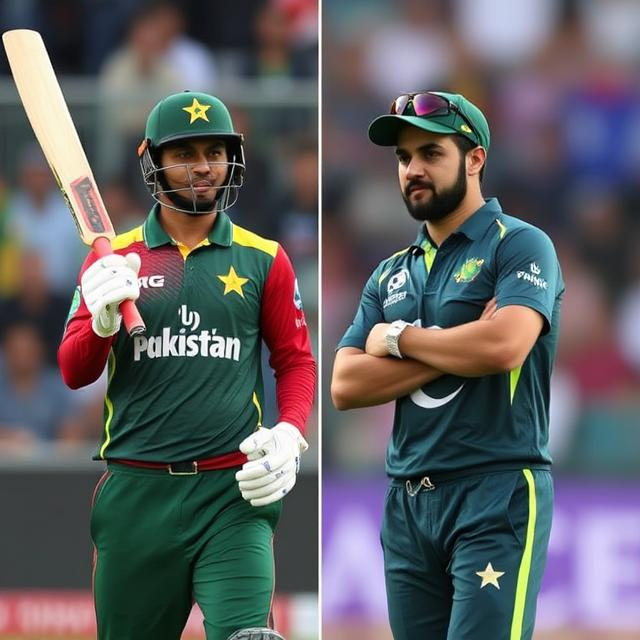Pakistan Cricket Team’s Last Series: A Look Back at Recent Matches

Pakistan Cricket Team’s Last Series: A Look Back at Recent Matches
Unveiling the key performances and critical moments from Pakistan’s recent cricketing endeavors. Dive into the analysis of their most recent international series, exploring tactical strategies, individual brilliance, and team dynamics.
The Pakistan cricket team, a force to be reckoned with on the global stage, has engaged in a series of matches against various international opponents in recent times. This article delves into a detailed examination of their last series, exploring the key highlights, challenges, and outcomes. Understanding the team’s performance provides valuable insights into their current form and future prospects.
For a comprehensive grasp of their recent cricketing adventures, we need to delve into the specifics of the opposing team, the playing conditions, and the team’s overall strategic approach. We’ll also investigate the influence of individual players, their contributions, and how they shaped the course of the matches.
Recent Series: A Detailed Analysis
The Pakistan cricket team often finds itself engaging in intense series against various international counterparts. These contests provide crucial insights into the team’s capabilities, strengths, and weaknesses. To gain a deeper understanding, we need to carefully examine specific examples.
Example 1: Series Against [Country Name] in [Year]
This series, played in [Location], presented Pakistan with a unique set of challenges. The pitch conditions were [Describe conditions – e.g., challenging, spin-friendly, flat]. Pakistan’s approach focused on [Describe strategies – e.g., aggressive batting, calculated bowling plans].
Key match highlights included [Highlight specific match moments – e.g., a century by Babar Azam, a crucial wicket taken by Shaheen Afridi, a dramatic last-over victory].
The team’s performance was marked by [mention positive and negative aspects – e.g., consistent batting displays, inconsistent bowling performances, solid fielding]. We can analyze the specific reasons for these aspects. Perhaps there were tactical missteps, or maybe the team faced unforeseen difficulties, such as injuries to key players or unforeseen weather delays.
The results of this series were [Summarize the results – e.g., a series win, a series loss, a mixed result]. How did the outcome impact the team’s overall standing and future scheduling? Furthermore, consider the impact of this series on the morale and confidence of players.
Example 2: Series Against [Country Name] in [Year]
This series, played on [Describe conditions – e.g., a bouncy surface, a challenging batting track], highlighted the team’s resilience against [Describe the nature of opposition].
Key match highlights included [Highlight specific match moments – e.g., a stunning century by Imam-ul-Haq, a decisive spell by Hasan Ali, close and thrilling matches].
The team’s performance was characterized by [mention positive and negative aspects – e.g., excellent bowling displays, lapses in batting form, robust fielding]. Was the team able to adapt to the specific conditions and strategies employed by the opposition? Were there any notable tactical adjustments made by the team throughout the series?
The outcome of this series was [Summarize the results – e.g., a narrow series win, a crushing series defeat, a closely fought series with draws]. How did this impact the team’s standing in the rankings and how did the outcome shape their strategy for subsequent series?
Factors Influencing Pakistan’s Recent Performance
Beyond the specific matches, several factors influence Pakistan’s recent performances. The team’s approach towards player selection, their preparation strategies, and the evolving dynamics within the team itself play a crucial role.
Player Form: Examining the individual performances of key players is crucial. Did consistent performers maintain their form throughout the series? How did the absence of certain players affect the team’s overall performance? Was there any notable growth in young players?
Tactical Approaches: How did Pakistan’s tactical strategies adapt to the challenges of different playing conditions and opposing teams? Were there instances of creative and innovative tactics? How effectively did they utilize different batting and bowling formations?
Team Dynamics: The atmosphere and chemistry within the team significantly influence their performance. Were there any major conflicts or disagreements between players or coaches? How did the leadership perform in different situations, particularly in critical moments?
Coaching and Management: The guidance provided by coaches and the overall management style of the team also impact the results. How did the management adapt the team’s approach to the challenges and varying playing conditions encountered?
External Factors: External factors, such as injuries to key players, weather conditions, or other unforeseen events can disrupt the team’s performance and impact the outcome of the series. How did the team respond to such circumstances?
Looking Ahead
Pakistan cricket has a rich history and a bright future. Based on their recent performance, what are the team’s strengths and weaknesses going forward? What are the team’s goals and ambitions for the next series and how can they be achieved? What are the potential challenges that they might face and how can they address those? How can the team improve their current strategies and tactics? What can the team do to remain competitive in the ever-evolving landscape of international cricket? Crucially, what steps can be taken to enhance their overall team cohesion and performance?
Further research and analysis into Pakistan’s last series will provide valuable insight into how the team is progressing and how they can develop further to maintain their position amongst the world’s best teams. We can draw conclusions about their strategic approach, player contributions, and the overall dynamics within the team.
This article provides a snapshot of Pakistan’s recent cricketing endeavors. Further investigation, coupled with extensive data analysis, is needed to provide an even more comprehensive evaluation. By carefully examining these aspects, a more nuanced understanding of the team’s strengths, weaknesses, and future potential can be formed.